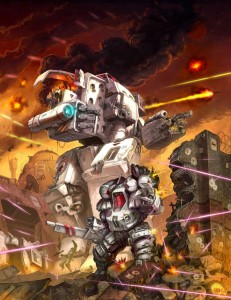I remember standing in a hobby store with my older brother. He was probably there to buy more Car Wars material. I had been wandering the dusty aisles, past ziplock bags of dice and rules printed on dot-matrix printers. I reached up to a shelf and pulled down a book covered with giant robots. It was a BattleTech manual. (I think it was one of the early, unauthorized Robotech supplements, thus proving that anime was in my blood.)
I opened this book and began to read. My mind spun, trying to comprehend dozens of pages packed with tables and numbers. I put it back on the shelf, cowed and intimidated by this game.
I kept that impression for twenty years.
Fast forward to PAX East 2013. I was walking into the tabletop area with a few friends at the beginning of the first day. My eyes fell on a table covered with hex grids, small mountains, and little toy train trees. And little plastic mecha models. Laying in a heap on a corner of the table: a few pamphlets emblazoned with a BattleTech logo.
Like a young child, I pointed and yelled, “BattleTech!”
My friends blinked at me, and I turned to them and said, “I wanna play this.” Excitement must have crept into my voice, because a few agreed to play with me.
I sat down, and a friendly guy walked over and offered to teach us how to play a basic game.
I loved it. More importantly, I understood it.
This undoubtedly is due at least in part to our guide’s clear explanations. He knew exactly what to explain and when to explain it. He gave us just enough choices to keep us interested, and as we got ourselves into dangerous situations, he’d explain the rules that governed that. Then as we got a hang of the game, he backed off.
I won’t try to explain the rules here, because I think a textual explanation just won’t do the game justice. Check out the Quick-Start Rules. Broadly: you calculate the defender’s to-hit number, which is 4 plus modifiers based on cover, damage to the mech’s systems, etc. For each attacking weapon, the attacker rolls 2d6, adds them together, and hits if the result is equal to or greater than the to-hit number. Damage is specified by the weapon, and is usually a static number. You also roll 2d6 to determine where you hit the enemy; each part of a mech has its own amount of armor.
One thing I love about the game is the relative fragility of mechs. A mech degrades quickly but can stay in a fight for a surprisingly long time. The game is a matter of managing failure, doing your best to stay in the game with a rapidly deteriorating mecha.
And because of the world’s fiction–innumerable fights across hundreds of worlds–I didn’t get too caught up in the outcome of that one battle. You do your best, but this is war: you’ll lose a good number of battles.
Overall, I can’t wait to play again.
You can download the Quick-Start Rules for free.
